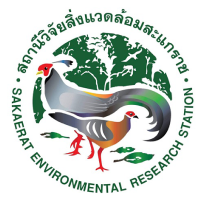Keywords :
Detrended Correspondence Analysis (DCA); Ecological Niche; Forestry Research and Training Station; Generalized Linear Model (GLM); Geoinformatics System
บทคัดย่อ :
Understanding tree distributions in the context of ecological niches is critical to conserving and restoring sensitive forest communities, such as dry evergreen forest (DEF). This study determined the distributions of dominant tree species in relation to environmental factors in a recovering DEF. In 2016, a 3 ha permanent plot (150 m x 200 m) was set up in lowland DEF on the Wang Nam Khiao Forestry Research and Training Station, northeastern Thailand. Each tree with diameter at breast height (DBH) >= 2 cm was tagged and identified, and its DBH and position (X, Y) were recorded. Topographic
factors and soil properties were selected as important environmental variables. The tree distribution in the plot was analyzed using detrended correspondence analysis (DCA) and generalized linear model (GLM) methods. DCA indicated that tree distribution was strongly influenced by the topographic gradient, which affected the soil bulk density (p < 0.05). Using the DCA diagram, two forest communities were identified; the first was distributed in areas of high elevation and steep slopes, while the second was characterized by high soil bulk density, which was mostly found in low-lying plateau areas, particularly near the stream bank. The GLM results showed that the native species, Walsura pinnata, was mostly in low-relief areas along the stream (p < 0.05), likely to minimize water stress. In contrast, Hydnocarpus ilicifolia and Streblus ilicifolius generally occupied ridge areas (p < 0.05). The results indicated that ecological niches varied among species, following environmental patterns. These findings can be applied to restoration programs, allowing suitable species to be selected for planting based on their niches.
เอกสารอ้างอิง :
Marod, D., Phumphuang, W. and Wachrinrat, C., 2021. Effect of environmental gradients on tree distribution in lowland dry evergreen forest, northeastern Thailand. Agriculture and Natural Resources, 55(5), pp.795-805.



